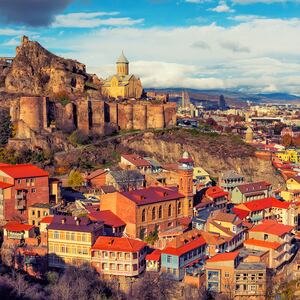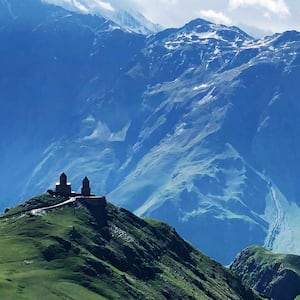When fording a rushing river in a 4x4, there are a few tricks to remember if you don’t want to die: cross on the diagonal, never change gears in the water, and if you start drifting downstream, throw open the doors—fast. “Water comes in, floating stops, and the jeep can go out,” said Kartlos Chabashvili, my mountain guide.
He was bracing me for one of the most dangerous drives in the world. The dirt track up and over the Greater Caucasus via the 9,300-foot Abano Pass is plagued with avalanches, rock falls, and vodka-swilling mountain men careening around switchbacks in Soviet trucks. But so be it—I was on my way to Tusheti, a region in northeast Georgia whose untamed alpine beauty, ancient stone towers, and elusive, mystical people were by all accounts worth risking one’s life to visit.

A view over Keselo fortress in Omalo.
I’d been visiting Georgia twice a year since 2014, chasing down travel stories from Tbilisi to the Black Sea coast, but Tusheti, which borders Chechnya and Dagestan (both in the Russian Federation), had always been out of reach. The region is so remote that the lone road in wasn’t finished until 1982; it’s snowbound nine months of the year. Even at the height of summer, it takes six hours of nauseous off-roading from the nearest town to reach the first Tushetian hamlets, and once you’ve arrived, you can all but forget creature comforts like cell service, internet, ATMs, and heat. But I was sold: The promise of an off-the-grid adventure in one of the last truly wild corners of Europe was too enticing to pass up.
That’s how I found myself riding shotgun with Kartlos, a longtime friend and the founder of InterGeorgia Travel, lurching up hairpin turns toward the Russian border as Lela Tataraidze’s “Ra Lamazia Tusheti” (“How Beautiful Is Tusheti”) quavered over the stereo. Out the window, the dusty farmscape of the Alazani Valley gave way to lush groves of boxwood, birch, and pine. A sudden racket of unfamiliar bird calls in the canopy reminded me I was in a protected national park. (Georgia may be smaller than Ireland, but it boasts more endemic flora and fauna than any other European country, barring Russia.) Here, in the 440-square-mile Tusheti Protected Landscape, you might spy mountain goats, imperial eagles, brown bears, and, if you’re lucky, rare indigenous species like the Caucasian black grouse and East Caucasian tur, a goat-antelope with horns so enormous they look like they belong on a triceratops. There are even occasional, if uncorroborated, Persian leopard sightings.
At the treeline we hit a traffic jam—of the ovine variety. Kartlos leaned on the horn, cursing in Georgian at the wooly expanse. “Rush hour in Tusheti, brother,” he said, raising his palms in a whaddya gonna do gesture. More like rush season: Every spring, one of the world’s most awe-inspiring animal migrations unfolds among these hills as tens of thousands of sheep make their way from the East Georgian steppe over the Greater Caucasus to the upland pastures of the Pirikiti Mountains, where they graze through the evanescent summer. No matter where you are in Tusheti, you can almost always spot a flock in the distance, inching across some faraway slope like an army of tiny white ants. Scenes like these have defined Tusheti for millennia.

In Parsma, the only people around were these locals on horseback.
The SUV revved and wheezed as we neared the Abano Pass. Cars lose about three percent of their torque for every 1,000 feet of gained altitude, and we were pushing 8,000. The strain on the motor was palpable. The curves were getting tighter now—so tight that Kartlos had to make k-turns at times to round them. We’d reached the road’s most hazardous stretch, a slippery vertical zigzag carving toward a snow-crowned summit, where we’d start our descent.
A thick fog—or maybe it was a cloud—suddenly engulfed the car, cutting visibility down to a few yards. As I counted the eyelets on my boots—anything to not dwell on the gray abyss out the window—it dawned on me that the tiny shrines I’d been seeing at the road’s edge weren’t Georgian Orthodox sanctums but memorials to dead travelers. So much for my tough-guy schtick: “We’ll, be OK, right?” I whispered to Kartlos, who’d been quiet for several minutes—a record in our friendship. “Of course we will,” he said, cracking a smile. “This is the fun part—adrenaline porn.”
For me the fun part came an hour later, as my heart palpitations subsided and the first signs of Tushetian civilization came into view. Perched atop green-velveted gorges, centuries-old towers called koshkebi sat like motionless sentries, vestiges of a not-too-distant era when locals depended on them for refuge against marauding bandits, fatal avalanches, and foreign armies (Tamerlane famously swept through Tusheti and plundered all he could). Even the ruined ones were magnificent: four stories high with tapered black-slate walls that remained largely airtight and impenetrable. I’d seen similar structures in Svaneti, Georgia’s western mountain region, but the Tushetian ones were more slender and intricate, evidence of a prosperous, habile community.

Keselo fortress in Omalo.
Lone watchtowers gave way to clusters of ramshackle houses as we made the final ascent toward Omalo, Tusheti’s main village (population: 34). Smoke from a chimney plumed over the ridge and cowbells clanged in the distance—the first hints of humanity in six hours, save for the odd grizzled shepherd. By the time our wheels crunched to a halt outside Tushuri Koshkhi, our guest house, the jeep looked like it had won a mud bogging competition. We got out and stretched our groggy limbs. Kartlos reached up for a high-five: We'd made it.
Tushuri Koshki is a traditional Tushetian home complete with a wide stone hearth and restored tower. We’d be staying on the second floor of the latter in a 15’ x 15’ cubby hole with creaky, downward-slanting floors and a cold-water-only bathroom—if we could maneuver our luggage through the hand-hewn doorway, built for lilliputian ancients, not 21st-century hotel guests. Appointed with handmade wooden furniture and heavy woolen blankets, the space was such an anachronism that I felt like I was breaking character every time I took out my phone.

These "modern" houses in Omalo were built after the towers were rendered obsolete.
A testament to Tusheti’s millennia-old shepherding tradition, wool is everywhere in Tushuri Koshki: on the walls in the form of felt artwork; in the one-drawer “gift shop” selling dozens of socks knitted by Tsalia Bakhturidze, the gentle patronne (“I get bored in winter,” she told me); and underfoot as elaborately patterned carpets, or pardagi, which are a Tushetian specialty and can take up to six months to weave. Quilts here are 20-pound, hand-felted behemoths built to ensure survival through harsh Caucasian winters. They give trendy weighted blankets a run for their money: You can keep your MBSR and Kundalini yoga— I’ll be here, as serene as a Tibetan monk, huddled under the covers in my tower.
I awoke the next morning to the the muffled thump of hooves hitting dirt. Our horses were being saddled up for a ride to Keselo, the 14th-century fortress complex in Zemo (Upper) Omalo. With bellies full of bread and guda—a local ewe’s-milk cheese that gets its pleasant putrescence from aging in sheepskin—we were on our bouncy way. Only up close can you fully appreciate the ingenuity of the towers, with their triangular arrowslits and fearsome machicolations, openings above doors from which any range of nasty liquids could be dumped over enemies.
Medieval Tushetians did not mess around—they had their freedom to protect. From the earliest written records until well into to the 17th century, they enjoyed virtual autonomy as a tribal democracy. Although Tushetians coexisted fairly peacefully through the centuries with neighboring tribes such as the Chechens, Khevsurs, Lesghians, and Hinukhs, and traded often with them, they remained culturally distinct with their animist deities, transhumant lifestyle, fast-footed dances, and twangy dialect. (Not to get too deep in the weeds, but even within Tusheti you’ll find several ethnic subcultures including Bats, Kist, and Udi.)
I was pondering all of this when Kartlos pointed out a particularly ramshackle ruin. Tusheti’s forts, he explained, fell into disuse in the 18th century, when they were no longer needed for defense against the northern Caucasian tribes. Some towers were converted into dwellings or silos, but most were simply abandoned. In its heyday, Keselo was a 13-tower-strong acropolis. Today five stand tall, thanks to a privately funded restoration project. One tower houses the local ethnographic museum, packed with Stone Age relics, antique household items, and an evocative collection of black-and-white photography.
Tushetians had fended off the Persians, Ottomans, and Mongols, but no stone citadel could shield their homeland from the iron-fisted Soviets, who were intent on snuffing out indigenous, “non-Soviet” cultures across the USSR. By the 1950s, many Tushetians, males in particular, had suffered the same fate as the Crimean Tatars, Azeris, Kurds, and other ethnic minorities: exile, draft, or the Gulag. Those left behind were driven out of their centuries-old villages in the mountains and down into the valleys, where Communist apparatchiks could keep a closer eye on them. The resettlement was an enormous blow to Tushetian culture and solidified the seasonal migration pattern we still see today.
But against all odds, 23 hardy Tushetians are reclaiming the mountains as their year-round abode. They’re virtually cut off from civilization for eight months of the year. I sat down for tea with with one of them, Irakli Khvedaguridze, the following morning. Introductions were presided over by a golden eagle with a wingspan the length of an NBA shooting guard that swooped and dove just feet from Khvedaguridze’s creaky wooden verandah, perhaps the best box seat on earth to view Planet Earth-grade nature performances. “We get them all the time,” Khevaguridze said, unfazed.
The spry 77-year-old is the sole year-round resident of Bochorna, the highest permanently settled village in Europe at an altitude of 7,694 feet. A neurologist by trade, he’s assumed the role of regional doctor, making house calls on horseback in summer and on his homemade skis in winter. “I estimate I’ve saved around 29 people since moving back to Tusheti in 2010,” he said.

A cow grazes outside one of Tusheti's only brick-and-mortar churches in Diklo.
Thirty-one of the region’s 45 villages get no mobile reception, which means Khvedaguridze has to check on his compatriots in person to ensure they’re in good health. That often entails nine-hour slogs through waist-high snow. I felt a sudden urge to genuflect at this real-life superman’s feet. “I’m not a hero,” he insisted. “I’m just the middle man between God and the sick.” If you ever find yourself questioning faith in humanity, you’d do well to pay Khvedaguridze a visit.
Our next stop was Dartlo, a fairy-tale hamlet perilously perched above the Alazani river. Tusheti’s second-most populous settlement, it got a World Bank-funded facelift beginning in 2012 that rebuilt several towers and gussied up local guest houses with twee wooden balconies; since then, it’s been giving Ushguli a run for its money as Georgia’s most postcard-perfect village.
A fine walk starts at the base of the town, where there’s a ruined 19th-century church—built by Russians over a sacred Pagan shrine and subsequently razed by angry townspeople—and a fenced-in circle of chairs fashioned out of stone. This ring is where tribal justice was applied by a cadre of 12 elders (men and women) called khevisbrebi. The stone platforms in the middle, still visible today, were reserved for plaintiff and defendant. If you’re envisioning barbaric, Game of Thrones-style punishments, think again: The maximum penalty in Tusheti was temporary banishment from the community, a testament to the durability of the region’s social fabric.
Across the river and a five-minute climb up the hill, there’s a cluster of shrines called khatebi (sometimes referred to as salotsavi). Decked out with animal bones, crystals, and candles, these huts, ubiquitous in Tusheti, are hallowed praying places dedicated to Pagan-Christian demigods. Most locals identify as Georgian Orthodox Christians, but Tushetians still practice animal sacrifice on the doorsteps of these tiny chapels. Women, tourists included, are generally prohibited from entering them per an ancient code whose origins are unclear.

Making khinkali, Georgia's famous fist-sized soup dumplings. The Tushetian version is filled with caraway-scented lamb.
I’d worked up an appetite from my connect-the-khatebi hike and joined Kartlos for a hot bowl of kharsho, a spicy, brick-red beef soup, at Samtsikhe Guesthouse, where we’d post up for the night. A few local girls in the corner were blaring Georgian pop from a boombox and dancing around. A gallon of Natakhtari beer later, and we were right there with them, prancing and twirling like idiots to the rhythm of Mariam Elieshvili’s “Chven Akhla Erturts.”
Deeper into the Pirikiti Gorge, we wandered through villages virtually untouched by tourism. There was Parsma, an eerie, overgrown huddle of empty stone houses that sat under the gaze of lichen-covered towers, and Girevi, situated six miles from the Chechen border, which overlooks an impressive abandoned fortress said to have been defended by amazons. Shrouded in mist and blanketed in wildflowers, these lost villages are the stuff of fantasy novels.
As we pulled into Omalo for our last night in Tusheti, I couldn’t shake the feeling that the region, as I’d experienced it, was on the verge of being lost. New infrastructure had been laid to bring the internet to the larger townships. As I write this, there are mumblings in Tbilisi of a tunnel connecting Tusheti to neighboring Khevsureti, which would be a cultural and environmental nightmare. The Georgian government will decide in the coming weeks whether or not to pave the road over the Abano Pass, a move that would open the floodgates of mass tourism.
Over a final feast of lamb-stuffed khinkali, caraway-scented soup dumplings the size of my fist, I confided in the owner of the guest house, Omalo native Nugzar Idoidze (Tsalia’s husband), my worries about the region’s future: I’d spent enough time in Disneyfied cities like Mestia and Sighnaghi to understand the perils that come with a constant inflow of foreigners.
He put his hand on my shoulder. “The way I see it, the Soviets tried to destroy our culture, and they were almost successful. I grew up in an Iron Curtain country brainwashed by propaganda. If we Tushetians survived that, then we can survive anything,” he said. “We are proud of this paradise we call home, and in the Georgian tradition of hospitality, we are ready to show it off.”



